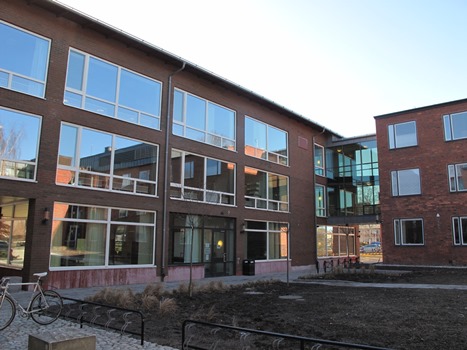KTH Campus
KTH Campus

Parts of Road and water (New construction 2014) meet the requirements for Environmental Construction Gold. Miljöbyggnad is a certification system for creating environmentally sustainable buildings. It is based on Swedish building and authority regulations as well as Swedish construction practice. Environmental building is a certificate of important qualities of a building in terms of energy, indoor environment and materials and is used for newly produced and existing buildings regardless of size. In Environmental Construction, a building can achieve the bronze, silver or gold rating. Behind the certification stands the non-profit association Sweden Green Building Council (SGBC).
Being a tenant in a certified building means a responsibility in the use of the premises and the building to create the smallest possible environmental impact. In order for the property to be able to maintain the certification, it is important that you as a tenant know what applies. This house guide contains information about how the building works and tips on what you as a tenant can influence.
If you have questions, you are welcome to contact your administrator at Akademiska Hus.
Waste disposal
Akademiska Hus is responsible for handling household waste and KTH for other waste fractions. Recycled paper is sorted locally in the kitchenette on each floor and some source sorting takes place in deployed environmental furniture. See internal waste procedures.
The building's waste room is in the extension, Teknikringen 72A, where waste is sorted into different fractions. The users themselves are responsible for the removal of packaging and pallets.
Generally
In order to obtain good air quality in the premises, the ventilation is adapted to the number of people and the equipment planned for the rooms. During very hot summer days, the indoor temperature is allowed to rise slightly.
Radiators
The building has radiators for heat and to prevent frostbite.
The thermostats must not be turned as the heating and cooling functions are controlled automatically and centrally. Also remember that the radiators must not be covered.
Office
In offices, the normal temperature can be influenced somewhat via a room regulator inside the door. If you turn the switch towards red it will be warmer and if you turn it towards blue it will be colder.
Keep in mind that a manual change of temperature can take a long time due to the thermal inertia of the building.
Conference room
In some rooms, the ventilation is controlled automatically via presence, temperature and carbon dioxide sensors. This means that the room climate is automatically adjusted according to the number of people staying in the room.
Extended operating time
The ventilation is switched off after regular office hours to save energy.
If ventilation is needed beyond regular office hours, a push button in the corridor can be activated for extended operating hours. Green diode indicates that the ventilation is on.
Generally
Lighting in public areas such as corridors and stairwells as well as outdoors is controlled by a superior control system for the Campus area.
In stairwells and corridors, lighting is controlled via a time channel during regular office hours. After the set time, the push button is used to light up again.
Corridors have some led lighting that is always on.
Office
The lighting in offices in the new and remodeling parts is turned on and off manually via a push button by the door. When no one is in the room, the lighting is switched off automatically via presence detectors.
Remember not to place furniture so that it obscures the "field of view" of the presence detector.
Conference room
In conference rooms in the new and remodeling parts, the lighting can be turned on and off manually, just like an office. When no one is in the room, the lighting is switched off automatically via presence detectors.
Evacuation alarm in case of fire
The building has smoke detectors that, in the event of a fire, automatically trigger an evacuation alarm in the building. The signal to evacuate is via the siren and red flashing light in the relevant part of the building.
In the event of a fire, call 112 as the evacuation alarm is not forwarded to the Rescue Service.
You can manually trigger the alarm yourself using push buttons in escape routes. Limit the source of the fire by closing windows and doors.
Of course, no two fires are the same and it depends on the circumstances how you should act in each individual case. Still, learn the basic rule:
ALARM - WARN - ALARM - EXTINGUISH
• save yourself and others around you, but don't take too many risks yourself
• warn others who may be in danger
• alert the emergency services by calling 112
• put out the fire if possible